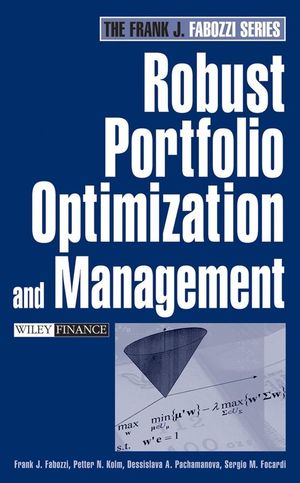Robust Portfolio Optimization and ManagementISBN: 978-0-471-92122-6
Hardcover
495 pages
June 2007
 This is a Print-on-Demand title. It will be printed specifically to fill your order. Please allow an additional 10-15 days delivery time. The book is not returnable.
|
||||||
About the Authors.
CHAPTER 1. Introduction.
Quantitative Techniques in the Investment Management Industry.
Central Themes of This Book.
Overview of This Book.
PART ONE. Portfolio Allocation: Classical Theory and Extensions.
CHAPTER 2. Mean-Variance Analysis and Modern Portfolio Theory.
The Benefits of Diversification.
Mean-Variance Analysis: Overview.
Classical Framework for Mean-Variance Optimization.
The Capital Market Line.
Selection of the Optimal Portfolio When There Is a Risk-Free Asset.
More on Utility Functions: A General Framework for Portfolio Choice.
Summary.
CHAPTER 3. Advances in the Theory of Portfolio Risk Measures.
Dispersion and Downside Measures.
Portfolio Selection with Higher Moments through Expansions of Utility.
Polynomial Goal Programming for Portfolio Optimization with Higher Moments.
Some Remarks on the Estimation of Higher Moments.
The Approach of Malevergne and Sornette.
Summary.
CHAPTER 4. Portfolio Selection in Practice.
Portfolio Constraints Commonly Used in Practice.
Incorporating Transaction Costs in Asset-Allocation Models.
Multiaccount Optimization.
Summary.
PART TWO. Robust Parameter Estimation.
CHAPTER 5. Classical Asset Pricing.
Definitions.
Theoretical and Econometric Models.
Random Walk Models.
General Equilibrium Theories.
Capital Asset Pricing Model (CAPM).
Arbitrage Pricing Theory (APT).
Summary.
CHAPTER 6. Forecasting Expected Return and Risk.
Dividend Discount and Residual Income Valuation Models.
The Sample Mean and Covariance Estimators.
Random Matrices.
Arbitrage Pricing Theory and Factor Models.
Factor Models in Practice.
Other Approaches to Volatility Estimation.
Application to Investment Strategies and Proprietary Trading.
Summary.
CHAPTER 7. Robust Estimation.
The Intuition behind Robust Statistics.
Robust Statistics.
Robust Estimators of Regressions.
Confidence Intervals.
Summary.
CHAPTER 8. Robust Frameworks for Estimation: Shrinkage, Bayesian Approaches, and the Black-Litterman Model.
Practical Problems Encountered in Mean-Variance Optimization.
Shrinkage Estimation.
Bayesian Approaches.
Summary.
PART THREE. Optimization Techniques.
CHAPTER 9. Mathematical and Numerical Optimization.
Mathematical Programming.
Necessary Conditions for Optimality for Continuous Optimization Problems.
Optimization Duality Theory.
How Do Optimization Algorithms Work?
Summary.
CHAPTER 10. Optimization under Uncertainty.
Stochastic Programming.
Dynamic Programming.
Robust Optimization.
Summary.
CHAPTER 11. Implementing and Solving Optimization Problems in Practice.
Optimization Software.
Practical Considerations When Using Optimization Software.
Implementation Examples.
Specialized Software for Optimization Under Uncertainty.
Summary.
PART FOUR. Robust Portfolio Optimization.
CHAPTER 12. Robust Modeling of Uncertain Parameters in Classical Mean-Variance Portfolio Optimization.
Portfolio Resampling Techniques.
Robust Portfolio Allocation.
Some Practical Remarks on Robust Portfolio Allocation Models.
Summary.
CHAPTER 13. The Practice of Robust Portfolio Management: Recent Trends and New Directions.
Some Issues in Robust Asset Allocation.
Portfolio Rebalancing.
Understanding and Modeling Transaction Costs.
Rebalancing Using an Optimizer.
Summary.
CHAPTER 14. Quantitative Investment Management Today and Tomorrow.
Using Derivatives in Portfolio Management.
Currency Management.
Benchmarks.
Quantitative Return-Forecasting Techniques and Model-Based Trading Strategies.
Trade Execution and Algorithmic Trading.
Summary.
APPENDIX A. Data Description: The MSCI World Index.
INDEX.



